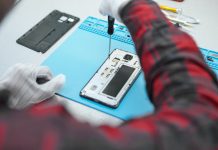During the pandemic, the demand for professional cleaning supplies skyrocketed. As a result, we’ve witnessed many businesses adopting new cleaning technologies to combat virus particles that we come into daily contact with to keep our loved ones safe.
In this article, we’ve listed the top 4 cleaning technologies that have emerged or gained popularity under the pressure of the pandemic.
1. Internet of Things (IoT) Technology
IoT technology uses sensors placed inside cleaning products such as paper towel dispensers, restroom soap, bins, and vacuum sweepers to capture and upload real-time data to the internet.
The data is analyzed to send alerts to custodians when supplies need restocking or when cleaning schedules need to be altered. IoT’s advantages include increased productivity and accuracy, greater insight into their operations, better cleaning results, and cost savings.
2. Electrostatic Technology
Due to the need to disinfect large indoor spaces such as businesses and schools, electrostatic spraying has drawn increasing attention. An electrostatic sprayer applies a small electrical charge to aerosols when passing through the nozzle. These charged droplets stick to environmental surfaces such as walls, floors, chairs, tables, and even fabrics to inactivate bacteria, viruses, and other pathogens.
While electrostatic technology is very useful for covering large areas, it is vital to train humans to ensure cleanliness. Please bear in mind that since these devices aerosolize chemicals in the air, without proper training and knowledge, they can irritate the eyes, skin, airways and cause other health issues for those who breathe it in.
3. Robot Custodians
Due to rising labor costs, workforce shortages, and limited resources, the pandemic has increased the demand for robotic/autonomous cleaning machines. Self-driving and programmable robots use built-in sensors and cameras to navigate surroundings efficiently. These sensors and cameras can collect real-time data that alert managers when tasks are complete or when refilling or maintenance is required.
The benefits that this technology provides are increased productivity, reduced costs, and enhanced customer experience. This is also beneficial for employees as it will free them from repetitive, labor-intensive tasks and focus on ‘high-value’ ones instead.
4. Ultraviolet (UV) Disinfection Technology
Although UV-C light has been used extensively since the 1800s to disinfect laboratories, hospitals, and industrial plants, it has seen a surge in popularity during the pandemic. Research has confirmed that the wavelength range of UV-C light is the most effective in inactivating bacteria and viruses, including the SARS-CoV-2 virus, which causes the COVID-19 disease.
The three commonly known ways to apply UVC for air and HVAC surfaces (heating, ventilation, and air-conditioning) are upper-air, HVAC surface/coil irradiation, and HVAC airstream disinfection. However, while this technology is 99.99% effective, workplaces need to be retrofitted to accommodate and incorporate UV technology which can be expensive and time-consuming. However, to bridge that gap, new technologies are emerging.
A team of physicists and engineers at Wolven Industries, led by CEO Mike Norton, has developed a robust, handheld, battery-powered, LED-based UV-C disinfecting device, called the uRay. It can help disinfect surfaces in seconds.
Unlike the UV-C cleansers on the market, the uRay is designed and built for both advanced efficacy, safety, and intuitive ease of use. It is designed to be a pocket-friendly size so that it’s easy to carry on the go. With it, you’ll be able to disinfect public surfaces, such as bathroom seats, shared keyboards, and public touch screens, to reduce your exposure to germs.
Despite its small size, the device includes a patent-pending reflective sheet behind the bulb that focuses 90% of the emitted UV light on the target surface, increasing the intensity of the radiation —all of this without installing specialty electrical devices and bearing the expenses. Wolven Industries’ handheld UV cleanser requires no maintenance and depending on the usage, you’ll only need to change the bulb once every 5-10 years.
Having said that, UV disinfection devices must be handled carefully as UV-C rays can put you at risk for skin cancer and cataract. Upon purchase, Wolven Industries provides its customers with complementary UV protective goggles.
Final Words
To counter the devastating effects of the pandemic, both businesses and individuals are seeking new and effective cleaning technologies. IoT, electrostatic, and UV technology along with robotics are among some of the top solutions. They are not only effective but also ensure fast disinfection.
However, just like with any technology out there, it’s crucial to select a reliable and professional provider as investing in low-quality equipment can lead to financial losses and unexpected infections.
Which one would you opt for?






